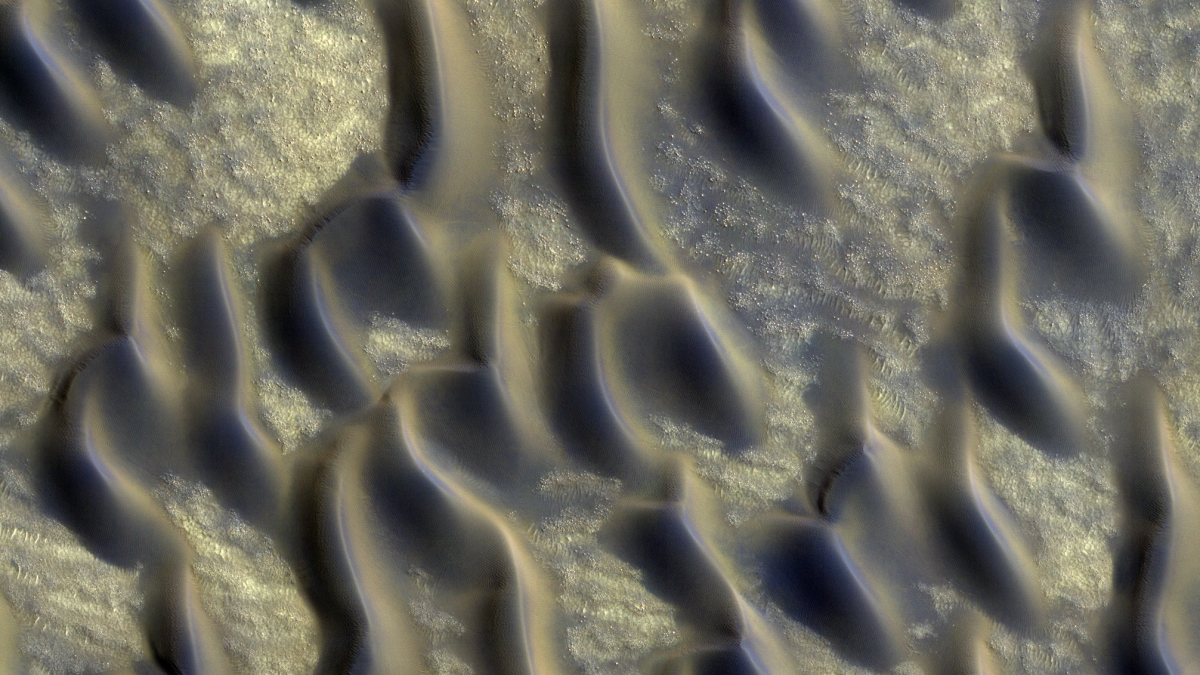The dark side of Mars: Study reveals weathered glass deposits

New study reveals dark patches on Mars are weathered glass deposits
If you look at a map of Mars, you will see a mosaic of dark patches and lighter spots covering the planet. The various shades represent different sediments, but the exact composition of those sediments is something scientists are still trying to figure out. As a result of a study conducted by researchers at Arizona State University, scientists are one step closer to understanding the geology of the red planet.
In a study published in the journal Geology, Jim Bell, School of Earth and Space Exploration (SESE) professor and Briony Horgan, SESE exploration postdoctoral fellow, report that the Martian northern lowlands are largely composed of chemically weathered glass.
Horgan and Bell began their research by collecting spectra data from the OMEGA imaging spectrometer on board the European Mars Express spacecraft. Because Mars Express is in an elliptical orbit, the spacecraft makes close passes over different areas of Mars, producing images from different times and elevations. The team used those images to produce a single map of the northern lowlands, and incorporated spectral data into that map. Translating spectral data, often represented in graphs, onto images made the spectra easier to analyze.
Once the team had the spectra mapped, they began to investigate the iron mineralogy of the sediments. The researchers found that the spectra they were observing had signatures that were consistent with a glass-rich composition.
“Glass is iron bearing, and it looks a lot like olivine and pyroxene, but it’s different enough that we can tell it apart,” explained Horgan. “When we started mapping this stuff out, we found that basically all of Acidalia Planitia, most of the north polar sand sea, and all of Utopia Planitia had that same glass signature. In total, that’s over ten million square kilometers of glassy surfaces.”
Based on lab studies, the team was able to determine that glass content of the sediments was approximately 80 to 90 percent.
“We hadn’t conclusively detected glass before on Mars,” said Horgan. “People had inferred that it must be there, since impacts and volcanoes create glass, but nobody had actually directly identified it before. So that begged the question – where did this stuff come from?”
Meteorite impacts can create glass, but usually not in the high concentrations that Horgan and Bell observed. Volcanoes, however, have the potential to create extremely large quantities of glass, especially explosive volcanoes that interact with ice and water.
Horgan and Bell used Iceland, a location where explosive volcanoes are common, as an analog to hypothesize about the conditions that could have produced the Martian glass they found.
Volcanoes in Iceland erupt underneath glaciers, and the interactions between water from the glaciers and lava from the volcanoes create incredibly explosive eruptions. The lava fragments, and transforms into particles of glass. Huge sand dunes and sand plain fields form that consist of 50 to 70 percent glass. Horgan and Bell hypothesize that the same process occurred during periods of volcanism on Mars.
This possibility presents an interesting new idea of Martian geologic history. Previously, mineral mapping evidence has been interpreted to indicate that most volcanism on Mars has been effusive (dominated by lava flows). These findings support the idea that explosive volcanism was also important in the planet's past, perhaps more important than previously thought.
Another intriguing finding is that the glass Horgan and Bell observed has been chemically weathered.
“When we see these glassy spectra, we also see a spectral signature that’s consistent with what happens when you expose glass to acid,” explained Horgan. “What that means is that these huge deposits are not only unique in that they indicate explosive volcanism, they also have experienced interactions with water.”
The northern lowlands were formed in the Amazonian epoch, the current and most recent geologic epoch on Mars. Scientists think of this epoch, which has lasted for approximately three billion years, as a very dry era, dominated by ice and snow. Horgan and Bell suggest that the chemical weathering observed on the glass is a result of melt from ice and snow during this epoch.
One question that begs further investigation is the exact nature of the glass deposits. Researchers are unsure of whether the northern lowlands are covered in a thick deposit of glass, or just a thin layer. The team also wants to see if sand dunes in other areas of Mars also exhibit these same glassy signatures. This could provide more support for the hypothesis of explosive volcanism on Mars.
Currently, the team at ASU is working on extending its map of Mars to cover the entire planet in order to explore some of the new avenues of research this study opens.
“The best you can do sometimes is to put these questions out there and intrigue your colleagues to get them to poke into it a little more,” said Bell. “And we’ll do some of that poking ourselves. There’s the whole rest of the planet to map.”
Written by Victoria Miluch